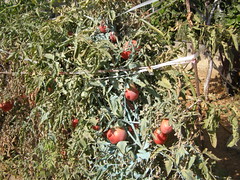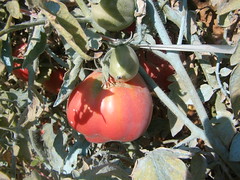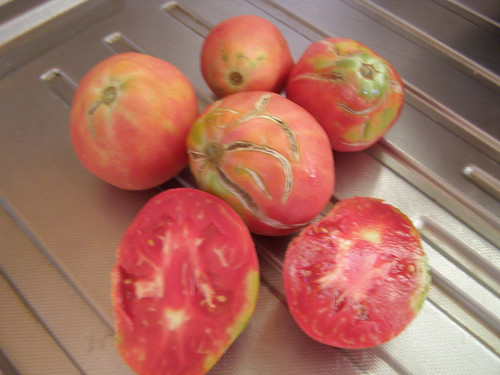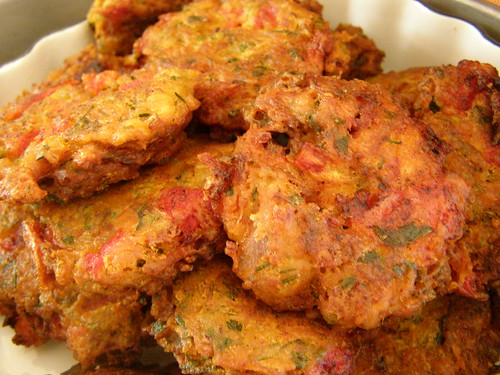Andrew from Very Good Taste lists 100 food items that he thinks “every good omnivore should have tried at least once in their life.” I'm not really a fan of memes (although I love themes), but I did find Lulu's and Kat's comments interesting on which food they have tried, and which they would never try. Andrew explains how he made up the list, which has proved immensely popular amongst food-bloggers. It is a challenge to find most of the listed food items in my area: for instance, crocodile, scotch bonnet pepper and fugu would have to be imported, and I doubt that there would be a huge market for them anyway. Some of the items on the list are simply too expensive for most people's pockets: I don't drink whisky, which is widely available all over the world, so I don't think I'll be dying to taste malt whisky from a bottle worth £60/$120 or more, which is on the list.
With a little artistic licence, most of the items on Andrew's list can be replaced by another local food item, in my case, Hania, of course; in other words, the same list can be made up with food items found in a different form in other parts of the world. Andrew freely admits that his ilist contains more curry and alcohol than necessary because of his origins (he's English), making the list non-definitive. Some of the items on the list are actually cooked meals, which can also be made at home using local ingredients and a good recipe, for example huevos rancheros and borscht.
One of the items on Andrew's list was heirloom tomatoes. Here's what one of the local varieties of non-hybrid tomato grown locally in Hania (in our garden) looks like.


We were given the seeds for this tomato from a neighbour who has been growing these tomatos for many years, and always collects seed from his previous crop before it dries up at the end of summer. This tomato has a pear shape, and is usually quite green near the narrow part where the stem is attached, even when fully ripened. For this reason, I usually slice off that little bit and discard it before using them in salads and all manner of tomato sauces. They tend to be softer than regular hybrid tomatoes, which is why I prefer to pick them when they are small. They smell heavenly, a sure sign that they are an old local variety of tomato. Another disadvantage of their appearance is that, as they grow larger on the tree, they create dark grooves on their skin, starting from the stem part. That's just the way they were born; we don't like many things about our own appearance, and we don't have the power to change that, either. It is mainly for this reason that I use these tomato in sauces and salsas, while we grow other varieties that are preferable in a salad.
Tomato fritters can be made with eggs or cheese or both, or completely vegan, which is what I prefer of my fritters. They are also a perfect dish for using our variety of heirloom tomato, and Nancy has an excellent recipe for lenten tomato fritters (tomatokeftedes, in Greek) on her website.
Tomato fritters can be made with eggs or cheese or both, or completely vegan, which is what I prefer of my fritters. They are also a perfect dish for using our variety of heirloom tomato, and Nancy has an excellent recipe for lenten tomato fritters (tomatokeftedes, in Greek) on her website.
I served these fabulous fritters when I invited some friends over for dinner. As I love to show off my garden produce in cooked form, I made snail stew, vegetarian lasagne, baba ganoush and kalitsounia (Cretan pasties) with vlita (amaranth) to serve with them, coupled with walnut pie (karidopita) for dessert. It was a truly grand feast!
This is my entry for Kalyn's Weekend Herb Blogging hosted this week by Ulrike from Kuchenlatein.
©All Rights Reserved/Organically cooked. No part of this blog may be reproduced and/or copied by any means without prior consent from Maria Verivaki.


Maria, I love tomatokeftedes! Do you know where I can find heirloom tomato plats in Greece? My inlaws planted some tomatoes in their garden that looked good but they werent tasty at all, so I think they might be a tasteless hybrid from Holland.
ReplyDeleteI am loving this time of year where all the tomato plants are producing and people are coming up with great ideas for them. Awesome idea and adding it to my to do list!
ReplyDeleteI love tomatos.
ReplyDeleteThese look so, so good! I have several types of heirloom tomatoes in my garden. A couple look similar to yours. Can't wait to find a chance to try these!
ReplyDeleteI haven't made tomato fritters yet (nor tasted them, to tell the truth, as Mama does not make these). But I love the idea of them! I'll have to try Nancy's recipe.
ReplyDeleteI tried these at a restaurant on Santorini. They were supposed to be legendary.I haven't yet tried to replicate them myself so thanks for the recipe:D
ReplyDeleteI hope this goes through ... I've tried to post a couple times now and my system is not cooperating!
ReplyDeleteLove the fritters, and I love the look of those tomatoes. Even with all their scars, they contain a beauty within. Your friends were so lucky to have you make these for them along with those other gorgeous dishes! Man, I wish I were your neighbor!
I've never made or had tomato fritters. They look amazing! I'll have to try a recipe soon as we are now experiencing our second wave of tomatoes.
ReplyDeleteMaria, your tomatokeftedes look wonderful...the photo drives home how delish these are!
ReplyDeleteIt's always better to cook with tasty tomatoes, than with watery ones. Thanks for sharing the recipe for WHB with us.
ReplyDeleteUlrike from Küchenlatein
I've never heard of tomato fritters before but I am definitely going to try it.
ReplyDeleteWow, that was definitely a feast that you made. Love the sound of tomato fritters. This year I have three kinds of heirloom tomatoes in my garden, but I haven't seen this type you're growing.
ReplyDeleteI love tomatokeftedes!! One of my favourite dishes.. Did you know that you can do great tomato balls with Santorinian cherry tomatoes? If you want check out my blog about Santorini island http://santorini-hotels.blogspot.com/
ReplyDelete